Long-tail keywords are extremely valuable because they often indicate a lot of buying intent, show specificity in that buying intent, and usually have less competition. If you can rank for these keywords, you can get in front of Googlers who are a) looking for your exact products or services, and b) intend to make a purchase.
But in our experience working with many dozens of companies over the years, most try to rank for them with product pages (eCommerce) or a few “Solutions” or “Use Case” pages (SaaS).
What we’ve learned after publishing and tracking hundreds of pieces of content is that the most effective way to rank for (all) the long-tail keywords that relate to your brand’s products or services is by creating dedicated long-form content — ideally, one piece of content for every long-tail keyword you’re going after.
Your Homepage Can’t Magically Rank for All of These Long-Tail Keywords
Ranking for use-case-specific keywords doesn’t happen by accident. You can’t just plug these keywords on your site pages and hope you will automatically rank for them. You have to create dedicated content to rank for super-specific, long-tail keywords. Why? Because:
- Homepages and product pages rarely have sufficient detail. They contain high-level copy about the brand and product that isn’t specific to any industry or reader.
- Industry or Use Case pages aren’t usually competitive enough to hit page one because, even though they have more focused information, they rarely satisfy search intent for long-tail keywords.
For example, look at the SERP for the keyword “accounting software for small business:” the first three results are all list posts comparing accounting software (in fact, 8/10 results on page one are all comparison posts).
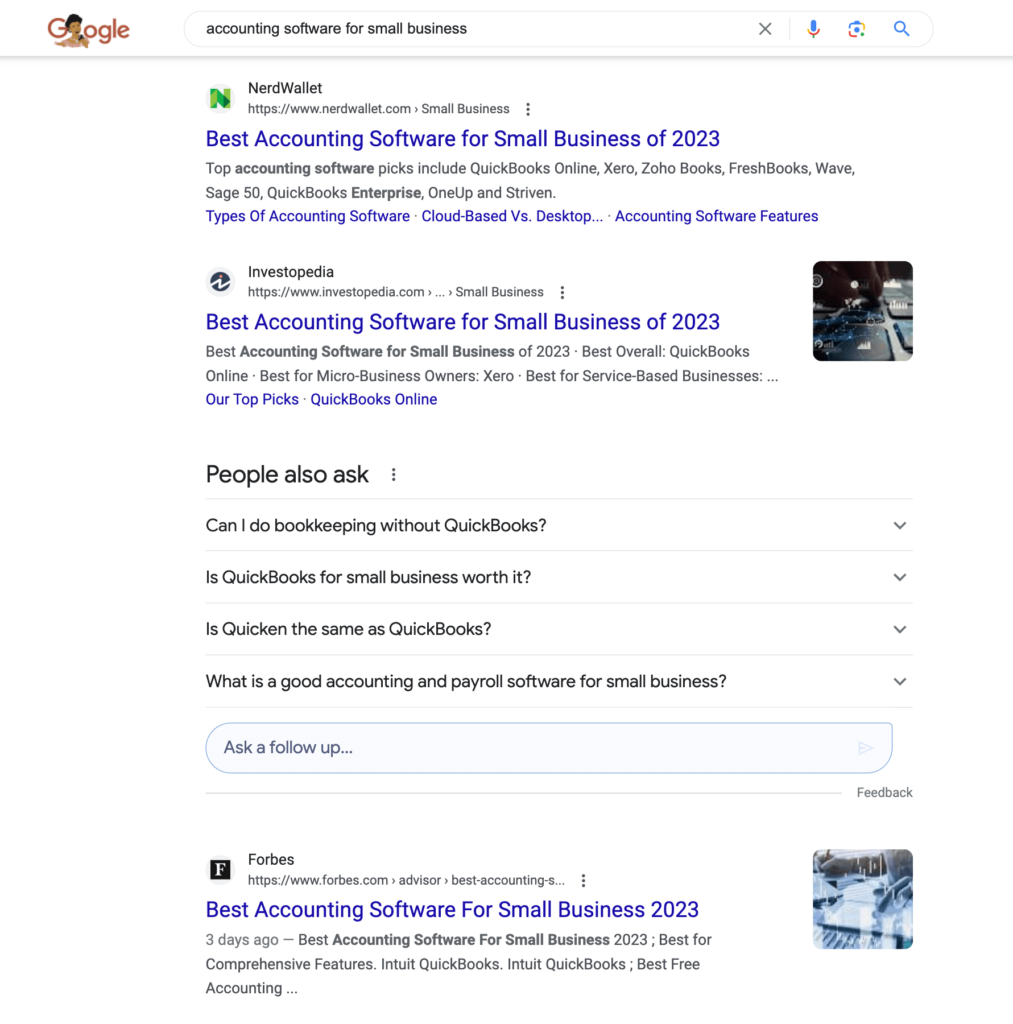
Google clearly favors list posts because that’s what best appeals to search intent — the searcher is shopping for accounting software and wants to find the best solution for their small business, it’s obvious that they will want to compare a few options before making a decision. So there’s just no way a homepage or landing page that talks about only one brand will rank for this specific search query.
To capitalize on these audience-specific keywords, you need to do the hard work of creating blog content that systematically ranks for each one.
Not only is this the most effective way to hit page one for these search terms, but by creating this content, you create opportunities to speak directly to all the different target audiences that are searching different long-tail keywords — their pains, what they hope to accomplish from their search — and describe in clear detail and with specific examples how your product can be tailored to their requirements. This specificity in your content is important for conversion rate.
We’ve done this work for dozens and dozens of clients and have seen time and time again that dedicated blog content outranks and outperforms landing pages sprinkled with industry-specific, long-tail keywords for the reasons above.
Below, we explain our process to rank for long-tail keywords. We’ll also run through a few case studies so you can see how we find these keywords for clients and the results from our work.
How to Rank for Long-Tail Keywords
1. Find Keywords That Are Closely Related to Your Brand, Products, and Services
The first thing to do is find the long-tail keywords that are most relevant to your offerings. These are typically variations of what we refer to as your main “category keywords” in our Pain Point SEO framework, that is, keywords that indicate the searcher is looking for your exact type of product.
The first group of long-tail keywords you should look at just add one layer of specificity to your most relevant category keywords.
In the example above, it was: accounting software (the primary product category) for small businesses (the layer of specificity). There are tons of examples that could fit this framework.
- Accounting software for nonprofits
- Professional accounting software
- Enterprise accounting software
- Accounting software for HVAC businesses
- Accounting software for eCommerce
- Accounting software for property management
- Accounting software for personal use
- Accounting software for beginners
This list goes on.
Choosing which of these layers of specificity makes the most sense for you comes down to considering your ideal customers and unique selling points — which audiences do you want to attract, which strengths or differentiators position you above competitors?
You can also think about long-tail queries that indicate searchers have a question, pain, or job to be done that your products or services satisfy. We call these “Jobs-to-be-Done keywords.” Look for queries that closely align with your brand offerings —the problems or jobs that you offer the absolute best solutions for. These are typically action statements or “how to” type searches.
Some keyword suggestions here are: how to organize purchase orders, track invoices and payments, or track mileage for taxes.
Choosing keywords that most closely align with your product or service is important for obvious reasons — the whole point of this SEO strategy is to get your name in front of the right audiences — but it’s also important for rankings because these are the queries where you have the most topical authority and the best chance of hitting page one.
Bonus: Using SEO Tools to Find More Long-Tail Keywords
There are plenty of keyword research tools to find long-tail keyword ideas, popular options include Semrush, Ahrefs, and Answer the Public.
Semrush is free to use (up to 10 searches per day) and a fairly popular keyword tool, so we’ll show you how this works with their features.
Start in the Keyword Overview tool and type the keyword phrase you want to search — one trick to find industry or user-specific long-tail keywords is to type “[software category] for” and see all of the results. For example, “accounting software for”.
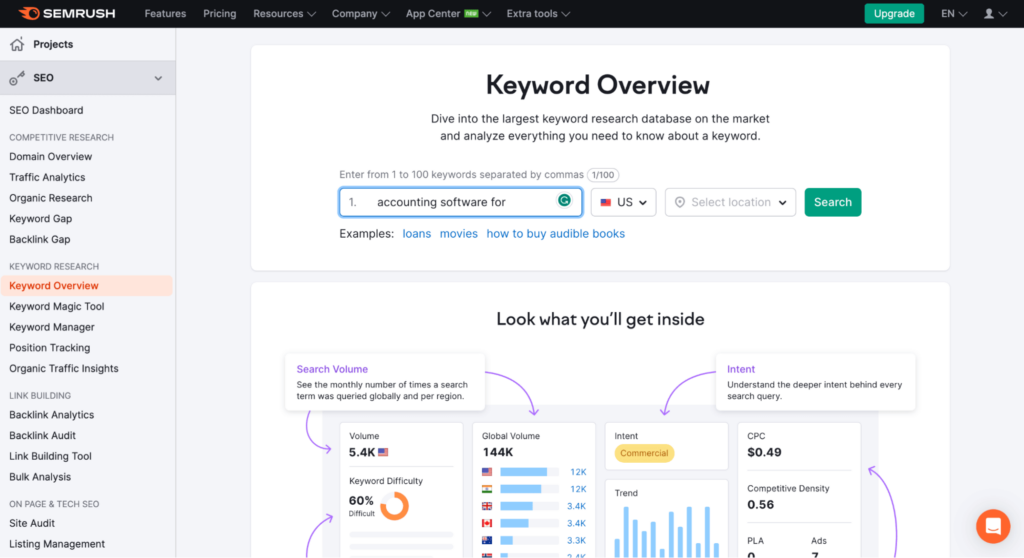
On the next page, you can see metrics like search volume, keyword difficulty, and CPC, then Semrush displays a list of keyword ideas below.
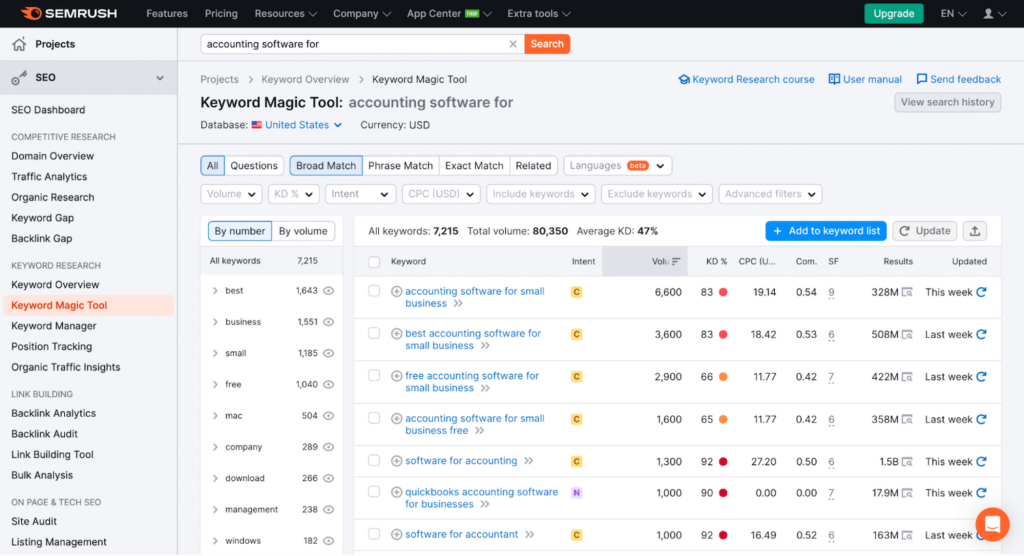
There are often an enormous number of these industry- or use-case-specific keywords with extremely high buying intent available — we see over 7K options related to accounting software — so you have to filter and use your best judgment.
Semrush displays categories on the right side (in the screenshot we see: best, business, small, free, mac, etc.) so you can easily filter keywords by topic. There are a number of additional filtering options. We suggest searching by term to find keywords related to your layers of specificity.
Ahrefs also has a free keyword research tool, where you can do similar searches. Note that they allow an unlimited number of searches, but only show the first 100 keyword ideas with limited metrics on the free plan (you can always upgrade to see the full list and all metrics).
Start by opening Ahrefs Keyword Generator and typing the keyword phrase. We’ll stick to our “accounting software for” example from above.
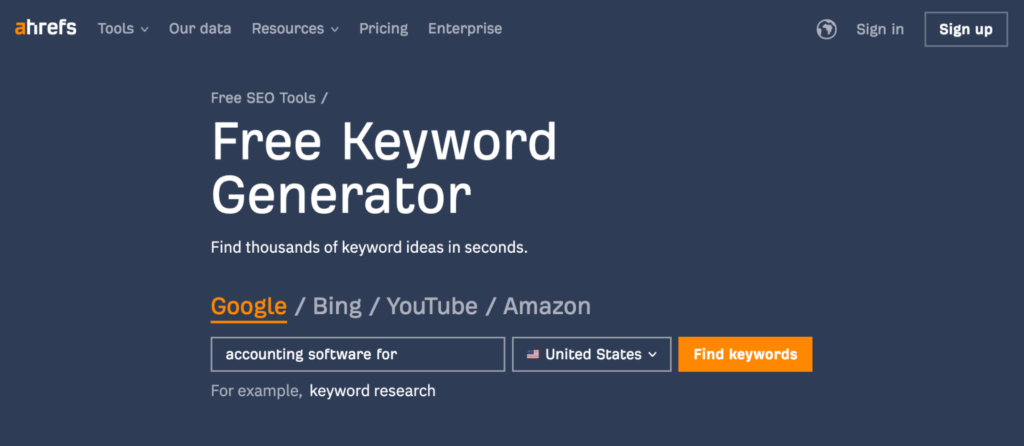
From there, Ahrefs displays a list of ideas. You can see keyword difficulty and search volume, and when those metrics were last updated.
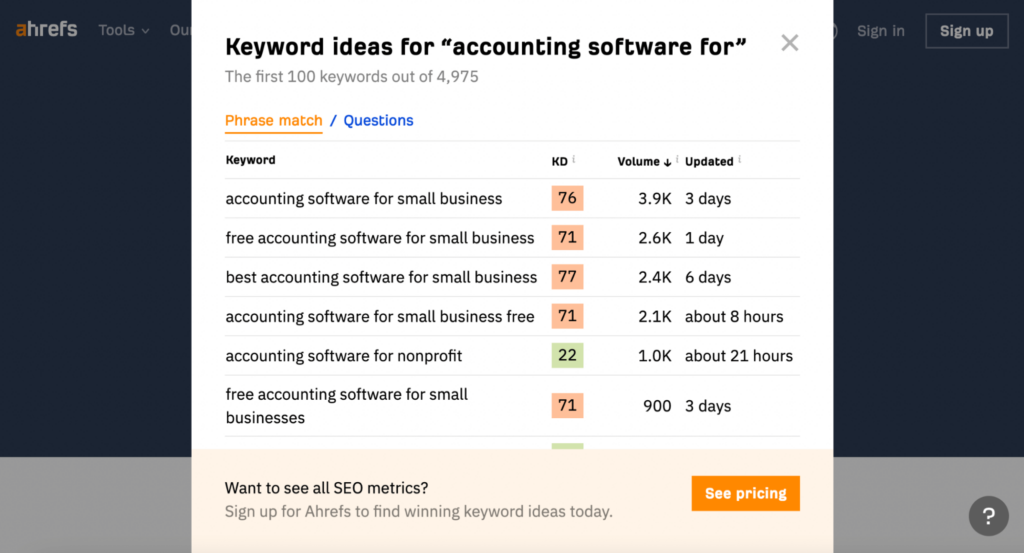
(Keep in mind, both Semrush and Ahrefs offer paid subscriptions with full access to these tools.)
Note: As per our Mini Volume Keywords article,we strongly caution against dismissing keyword opportunities solely because they have low search volume. Many of the super specific long-tail keywords will have lower search volumes, and this is to be expected because they are so specific; but as per that article, the actual traffic you get is almost always much higher than the stated search volume, and as per Pain Point SEO, the conversion rates can be so much higher than top of funnel, higher volume keywords.
2. Create a Dedicated Blog Post for Each Target Keyword
As we already warned, you can’t create a few landing pages or one massive “ultimate guide” that’s going to hit on every long-tail search that relates to your brand and offerings.
Think about it: the search results for best accounting software for small business will (and should) be different from results for enterprise accounting software or accounting software for eCommerce. These are three different audiences; they have different problems and require different types of solutions. You can’t possibly hit every vertical with general website pages.
The only way to effectively rank for each opportunity is to create a unique piece of content for each query.
Comb through your list of keywords to prioritize topics and plan an individual blog post for each one.
3. Perform SERP Analysis to See What Your Post Requires to Compete with Top Search Results
Before you start writing, it’s critical to analyze the search engine results page to figure out the search intent of your target keyword.
Remember, Google’s entire goal is to deliver the most helpful results to satisfy search queries, so the page one results offer a strong indication of what its algorithm favors or wants to show its users for your target keyword.
Consider again our example above — accounting software for small business:
One look at the SERP (screenshot above) tells us we need to create a software comparison guide. We can take research a step further, actually scanning through each content piece, to see what competitors they mention and any other topics they cover. Then we know what our post requires and can determine ways to improve upon what’s already ranking.
You can read more about SERP analysis in our SEO Content Writing guide.
4. Write Content to Appeal to Search Intent and Audiences
Tailor each content piece to the target audience — you need to touch on relevant topics and solutions to rank, but content also needs thoughtful examples, advice, opinions, recommendations, etc. to engage readers and satisfy search intent.
All of the “fine details” should be catered to the person reading the content.
In each piece, think about the target audience: their current processes and pain points, how your solution appeals to them, and the specific benefits your solution offers. This lets you speak to each audience more head on; you can drop in relatable quips about what audiences are doing now and how your solution solves their challenges. This gives you a much higher chance of converting the readers who land on your content.
We also wrote a guide on creating reader-centric and conversion-oriented content, which you can find here: Pain Point Copywriting: How to Write Compelling Sales Copy Inside Blog Posts
Here are a few examples of our work ranking clients for these industry-specific long-tail keywords:
Case Study #1: Ranking Digital Asset Management Software for Industry, Business Size, and Location-Specific Keywords
A client we recently worked with offers digital asset management (DAM) software. If you’ve never heard of DAM before, it’s essentially Google Drive on steroids, for companies that have tons of digital assets and several employees who need to find them, and thus for whom Google Drive or Dropbox aren’t enough.
Their primary audience is marketers and creative teams since these folks often store and share the most digital files. But, as you can guess, all kinds of businesses can benefit from DAM software, and our client offers features so they can work with small businesses, enterprises, and global teams. So our task was to find allthe long-tail keywords that would get our client in front of the right target audiences.
During our extensive onboarding interviews with their sales and marketing teams, we talked about:
- The DAM’s customizability — they can tailor their product to virtually any requirement, offering a “universal DAM.”
- All industries they could realistically cater to, and who to avoid.
- The DAM’s scalability and support for enterprise companies — these are the big ticket sales.
- Their onboarding services and custom pricing for small teams. Our client works primarily with enterprise brands, but one of their USPs was support for small, expanding businesses, so targeting small business keywords was a priority for them.
- The DAM’s global capabilities and expanding their reach beyond the US, into the UK, Australia, and APAC countries.
We found over a dozen highly specific, long-tail terms to create dedicated content. These were keywords around DAMs for different departments, different use cases, different company sizes, and more. After publishing, we saw 75% of blog posts for all “category + layer of specificity” keywords hit the first page of search results.
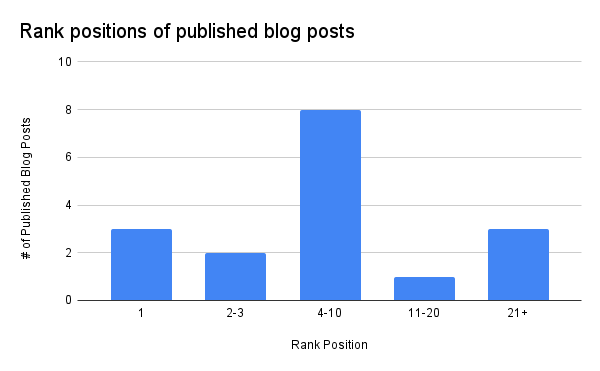
Case Study #2: Finding & Ranking a Unique Help Desk Software for the Right Layer of Specificity Keywords
Another client of ours who sold help desk software had a slightly different dilemma: they have a solution they can theoretically market across industries, however, their software is strictly an email management system with a few straightforward features, it does not have other help desk tools like live chat, voice, or social media messengers.
So we had two layers of specificity to determine during keyword research: the “help desk software” keyword variations specific to email management plus the additional layers of specificity determined by target audiences and unique selling points.
Here are some of the important findings from our strategy calls:
- The help desk is easy to use and offers affordable pricing, so they are a known choice for small businesses.
- On the flip side, they also have multi-brand features and global scalability, so they can support enterprise and international brands.
- They are one of the only help desk brands to offer a self-hosted solution, which can be essential for federal institutions or meeting GDPR compliance.
While we assume that anyone searching general help desk keywords could be interested in software with all the bells and whistles, our client is a good option for anyone needing an email-based, multi-brand, or self-hosted help desk. So we found specific category keywords related to ticket and email management, ease of use, cost, industry, business size, location, device, and hosting options.
Here’s a look at their ranking positions:
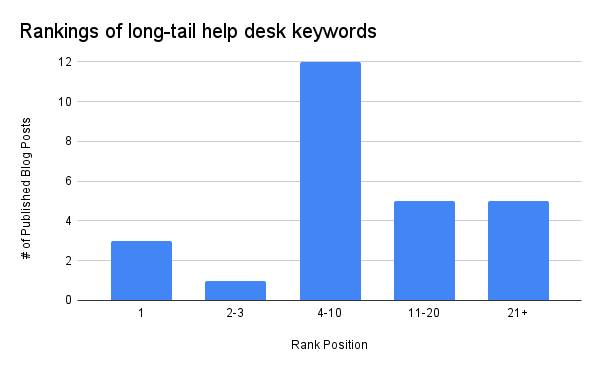
At first, rankings moved slowly; posts were indexing at positions 30+ and crawling to page one. So we:
- Performed quick SERP research for each piece of content to ensure blog posts still satisfied search intent and were competitive with what was already ranking.
- Built backlinks to promote content.
- Performed a technical audit to see if anything on the site’s backend affected the poor rankings.
After identifying and addressing subdomain issues, we saw these posts achieve top rankings — and they’ve sat on page one for 6+ months. They consistently drive traffic from search engines and convert website visitors, without us needing to update or “maintain” content.
Case Study #3: Covering Every Base for Time Tracking Software That Caters to All Industries & Business Sizes
The last client to talk about here sells an employee time clock software — a software solution that can obviously be used across any business with hourly employees.
In addition to time tracking, they also offered scheduling and payroll, support for field service teams via mobile apps, and flexibility to customize the software via integrations. They could work with virtually any organization interested in time clock software.
Since they sold a common software type and worked with businesses big and small, we had a lot of directions to go in during keyword research — some of the boxes we wanted to check were:
- All feature specific category keywords and their combinations. For example, keywords that suggest the searcher is looking for time tracking and payroll or payroll and scheduling. As an example from another industry (ours, SEO) it would be something like “keyword research and rank tracking tool.”
- All layers of specificity that apply to the product’s unique benefits. For example, many field service teams want GPS-enabled time tracking software so they can see where workers are clocking in from and their routes; since our client’s product has GPS, we could target GPS related keywords.
- Industry-specific keywords. This client wanted to capitalize on keywords related to contractors and construction teams since they had luck with these types of businesses in the past. However, they also wanted to hit on all industries they could (realistically) sell to — restaurants, hair salons, healthcare organizations, accounting firms, banks, insurance companies, and more are all good candidates for our client’s product.
- Small-business-related keywords. Our client’s product gets good feedback from reviewers for its ease of use, and they have packages for all team sizes, so they wanted to attract more small business users who were moving away from manual processes.
- Enterprise keywords. This client usually attracts mid-size and enterprise companies, so we wanted to double down on what was already working for them and pinpoint more of those same leads.
Over our years working together, we’ve written over 100 pieces of content targeting these highly specific, long-tail category keywords. And at the time of publishing, those articles rank for more than 100 BOTF keywords on the first page of Google search. (Many articles rank for more than one keyword.)
Note: In addition to ranking this client in top search positions for these keywords, our content brought in over 2,000+ conversions in 2022.
When we look at conversions by page, we see most top performers are blog posts written to target specific variations of main category keywords. For example, a category keyword related to construction drove 130+ conversions alone. Another category keyword related to a specific feature benefit generated 100 conversions.
And this is why we say you need dedicated content to capitalize on these keyword opportunities fully: there’s no way a homepage or landing page is going to rank for these specific keyword phrases, and even if they do, they won’t convert readers nearly as well as tailored content will.
Want to Work with Us or Learn More About Our Approach to Content Marketing?
- Our Agency: If you want to hire us to develop, manage, and execute your content marketing strategy, you can learn more about our service and pricing here.
- Write For Us: If you’re a content marketer or writer and would love to do content marketing this way, we’d love to have you apply to join our team.
- Our Content Marketing Course: Individuals looking to learn our agency’s content strategy and become better digital marketers, consultants, or business owners can join our private course, taught via case studies, and presented in both written and video content formats. We include several details and examples not found on this blog. Our course is also built into a community, so people ask questions, start discussions, and share their work in the lesson pages themselves, and we, along with other members, give feedback.








